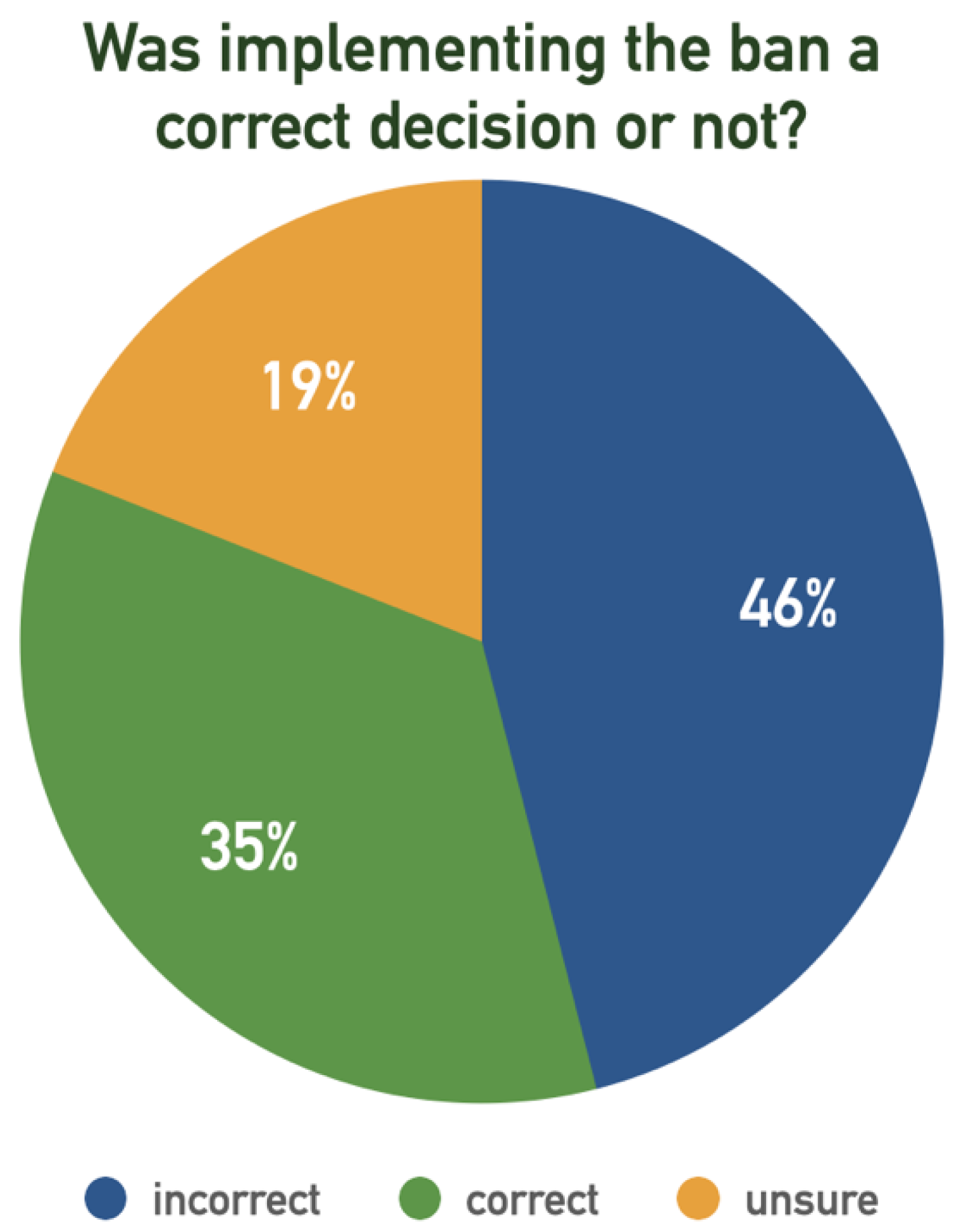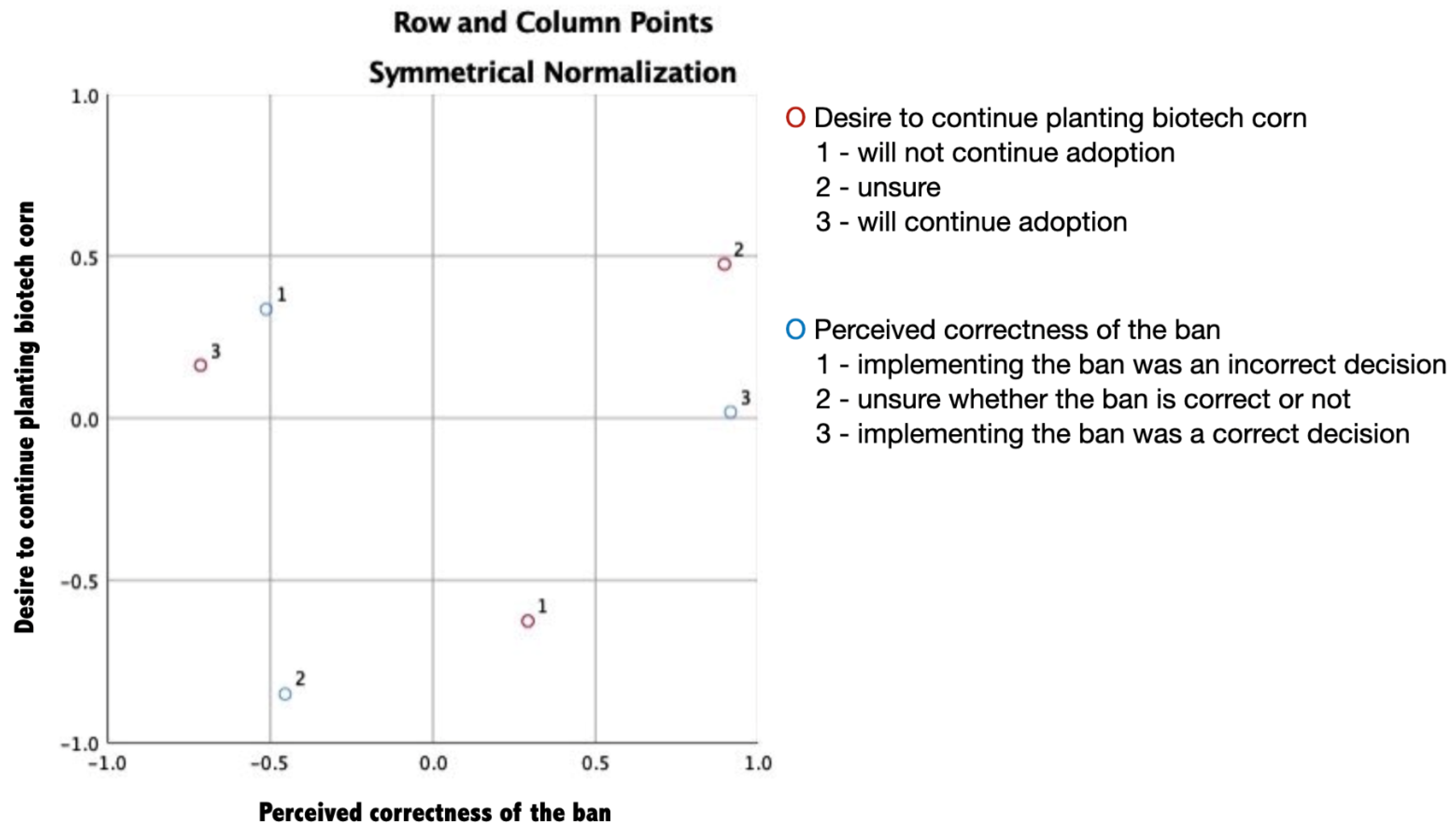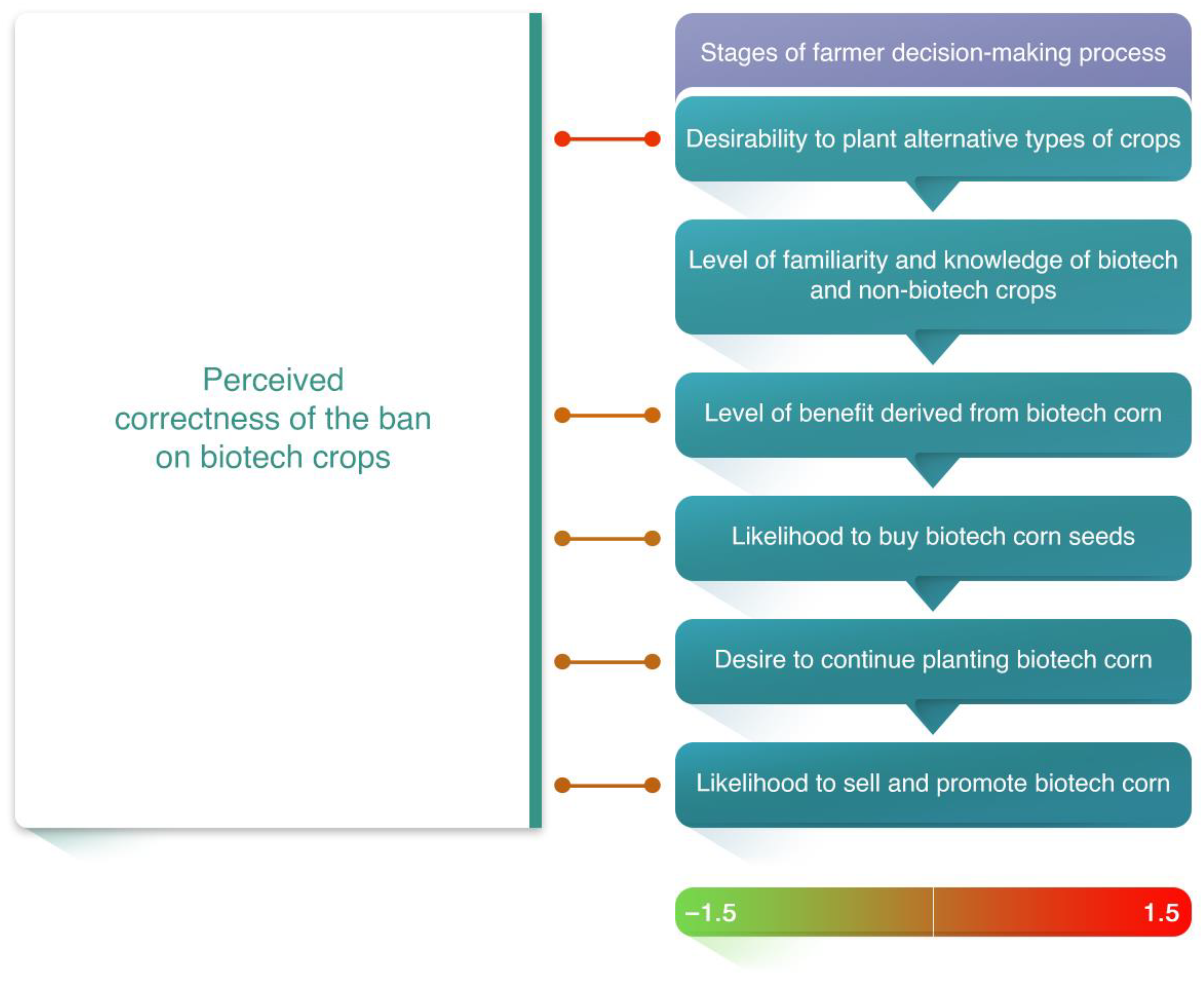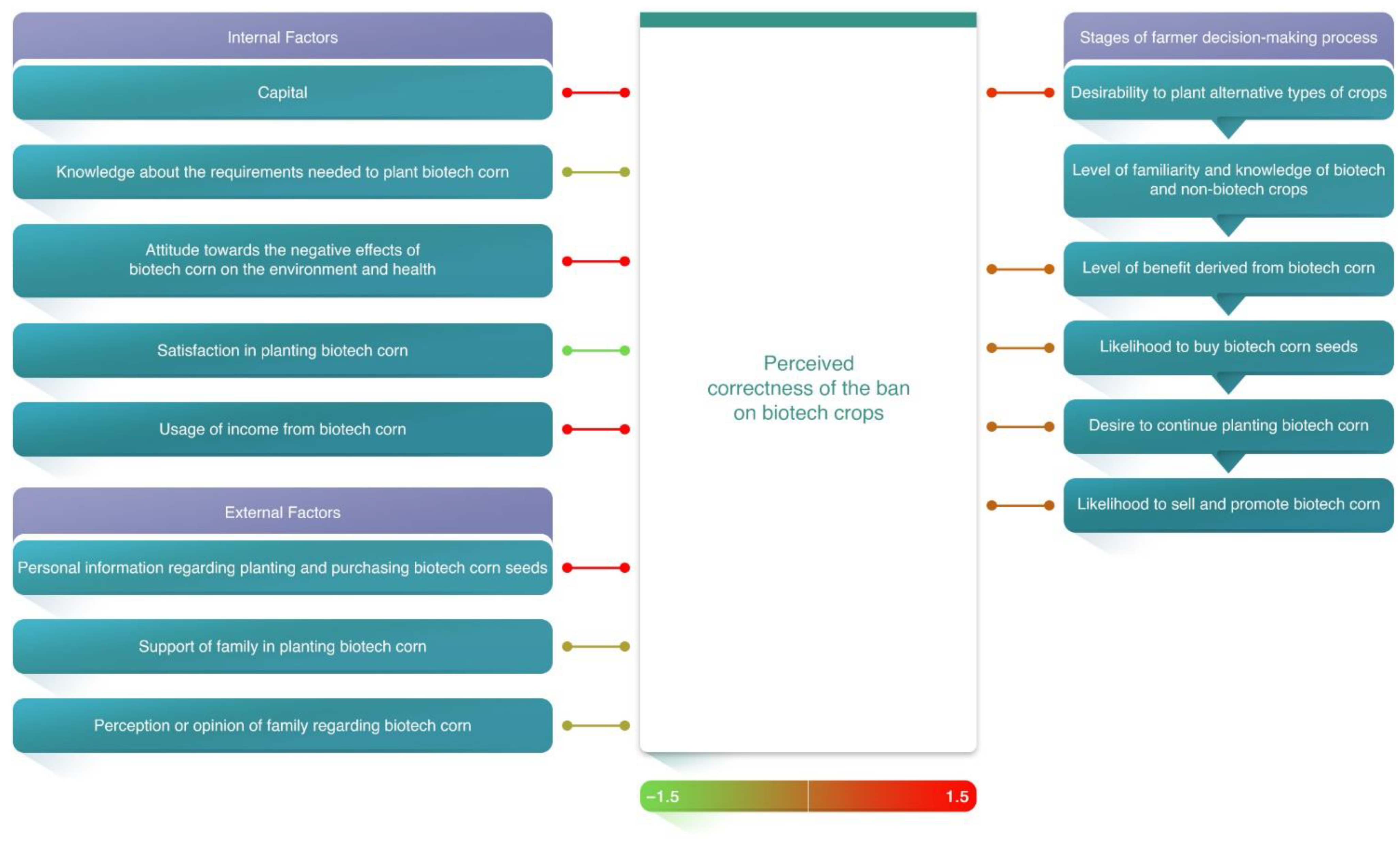Is Implementing a Biotech Ban Correct or Not? Analysis of Farmer Perceptions and Attitudes on the Philippine Supreme Court’s Ban on Biotech Crops
Abstract
:1. Introduction
Understanding Farmers’ Perspectives on Restrictive Policies
2. Study Area and Methods
Theoretical Framework
3. Results
3.1. Socio-Demographic and Farm-Related Data of Biotech Corn Farmers in Pampanga
3.2. Biotech Corn Farmers’ Perceived Correctness of the Ban on Biotech Crops
3.3. Exploratory Factor Analysis of Candidate Influential Factors
3.4. Relationship of Decision-Making Stages with Perceived Correctness of the Ban
3.5. Relationship of Internal and External Factors with Perceived Correctness of the Ban
4. Discussion
4.1. Two Major Themes of Farmer Perception on the Ban: Livelihood Sustainability versus Law Abidance
“The government will not subsidize the losses that we will suffer when we shift to non-biotech corn. The technicians have studied this crop, and we believe in what they advise because we can see for ourselves the good harvest it brings”.
“I continued to plant biotech corn because the government did not give any alternative seeds to sow, so we have no choice in the matter”.
“I have no choice but to plant biotech corn. If I switch to an alternative crop, all the pests will come to my farmland and my crops will get destroyed”.
“If biotech corn is still available in the market, we will still plant it; but if we can no longer find retailers/sellers for it, then we will stop planting”.
4.2. Farmers’ Decision-Making Process and Factors Affecting Farmers’ Ban Perception
“The health issues which they use as a basis for banning biotech corn are unfounded. The current trend in agriculture is continued research to help the farmers, so we should use the technology available”.
“The government should provide concrete evidence on why they are banning biotech corn and other biotech crops. If they can really prove that biotech corn is harmful to our health and the environment, then that is only the time to ban it in our country”.

“I benefit a lot from biotech corn. The money I provide to my family mainly comes from the biotech corn that I sell”.
5. Conclusions and Recommendations
Supplementary Materials
Author Contributions
Funding
Institutional Review Board Statement
Informed Consent Statement
Data Availability Statement
Acknowledgments
Conflicts of Interest
References
- FAO; IFAD; UNICEF; WFP; WHO. Brief to The State of Food Security and Nutrition in the World 2020. Transforming Food Systems for Affordable Healthy Diets; FAO: Rome, Italy, 2020. [CrossRef]
- International Service for the Acquisition of Agri-Biotech Applications (ISAAA). Global Status of Commercialized Biotech/GM Crops in 2019: Biotech Crops Drive Socio-Economic Development and Sustainable Environment in the New Frontier; ISAAA Brief No. 55; ISAAA: Ithaca, NY, USA, 2019. [Google Scholar]
- Yorobe, J.M., Jr.; Quicoy, C.B. Economic impact of Bt corn in the Philippines. Philipp. Agric. Sci. 2006, 89, 258–267. [Google Scholar]
- Yorobe, J.M.; Smale, M. Impacts of Bt maize on smallholder income in the Philippines. AgBioForum 2012, 15, 152–162. [Google Scholar]
- Panopio, J.; Navarro, M. Philippines: Drama and communication behind Asia’s first commercialized Bt corn. In Communication Challenges and Convergence in Crop Biotechnology; International Service for the Acquisition of Agri-Biotech Applications (ISAAA): Ithaca, NY, USA; Southeast Asian Regional Center for Graduate Study and Research in Agriculture (SEARCA): Los Banos, Philippines, 2011; pp. 43–80. [Google Scholar]
- Brookes, G. Economic and environmental impact of genetically modified crops in Asia Pacific. In Genetically Modified Crops in Asia Pacific; Gujar, G.T., Trisyono, Y.A., Chen, M., Eds.; CABI: Oxfordshire, UK, 2021. [Google Scholar]
- Alvarez, F.; Manalo, A.; Clarete, R. Economic Assessment of GM Corn Use in the Philippines. Int. J. Sci. Food Agric. 2021, 5, 115–128. [Google Scholar] [CrossRef]
- De Steur, H.; Stein, A.J.; Demont, M. From Golden Rice to Golden Diets: How to turn its recent approval into practice. Glob. Food Secur.-Agric. Policy Econ. Environ. 2022, 32, 100596. [Google Scholar] [CrossRef]
- Gerpacio, R.V.; Aquino, A.P. Socioeconomic Impacts of Bt Eggplant: Ex-Ante Case Studies in the Philippines; ISAAA and SEARCA: Laguna, Philippines, 2014. [Google Scholar]
- International Service for the Acquisition of Agri-biotech Applications (ISAAA). Global Status of Commercialized Biotech/GM Crops in 2017: Biotech Crop Adoption Surges as Economic Benefits Accumulate in 22 Years; ISAAA Brief No. 53; ISAAA: Ithaca, NY, USA, 2017. [Google Scholar]
- Gonzales, L.A.; Ignacio-Castillo, J.L. Socioeconomic and environmental impacts of GM corn in the ASEAN: The case of the Philippines. In Genetically Modified Crops in Asia Pacific; Gujar, G.T., Trisyono, Y.A., Chen, M., Eds.; CABI: Oxforshire, UK, 2021. [Google Scholar]
- De Leon, I.Z.P.; Custodio, P.A.; David, C. Depicting Science in a Public Debate: The Philippine Legal Challenge Against GMO Eggplant. Sci. Commun. 2019, 41, 291–313. [Google Scholar] [CrossRef]
- Vito, G.; Maahs, J.R. Criminology: Theory, Research, and Policy, 4th ed.; Jones & Bartlett Learning: Burlington, MA, USA, 2017; p. 439. [Google Scholar]
- Griffin, E.; Ledbetter, A.; Sparks, G. A First Look at Communication Theory, 10th ed.; McGraw-Hill Education: New York, NY, USA, 2019. [Google Scholar]
- Dreze, J.; Stern, N. The theory of cost-benefit analysis. In Handbook of Public Economics; Auerbach, A.J., Feldstein, M., Eds.; Elsevier Science Publishers B.V.: North Holland, The Netherlands, 1987; Volume II, pp. 909–989. [Google Scholar]
- Montes de Oca Munguia, O.; Pannell, D.J.; Llewellyn, R. Understanding the Adoption of Innovations in Agriculture: A Review of Selected Conceptual Models. Agronomy 2021, 11, 139. [Google Scholar] [CrossRef]
- Jha, S.; Kaechele, H.; Lana, M.; Amjath-Babu, T.S.; Sieber, S. Exploring Farmers’ Perceptions of Agricultural Technologies: A Case Study from Tanzania. Sustainability 2020, 12, 998. [Google Scholar] [CrossRef] [Green Version]
- Methorst, R.G.; Roep, D.; Verhees, F.; Verstegen, J. Differences in farmers’ perception of opportunities for farm development. NJAS-Wagening. J. Life Sci. 2017, 81, 9–18. [Google Scholar] [CrossRef]
- Bonzanigo, L.; Bojovic, D.; Maziotis, A.; Giupponi, C. Agricultural policy informed by farmers’ adaptation experience to climate change in Veneto, Italy. Reg. Environ. Change 2016, 16, 245–258. [Google Scholar] [CrossRef]
- Edwards-Jones, G. Modelling farmer decision-making: Concepts, progress and challenges. Anim. Sci. 2006, 82, 783–790. [Google Scholar] [CrossRef]
- Chen, Y.; Zhou, L.H. Farmers’ Perception of the Decade-Long Grazing Ban Policy in Northern China: A Case Study of Yanchi County. Sustainability 2016, 8, 1113. [Google Scholar] [CrossRef] [Green Version]
- Chang, G.Y.; Wang, L.; Meng, L.Y.; Zhang, W.X. Farmers’ attitudes toward mandatory water-saving policies: A case study in two basins in northwest China. J. Environ. Manag. 2016, 181, 455–464. [Google Scholar] [CrossRef] [PubMed]
- Zhenmian, Q.; Bixia, C.; Nagata, A. Review of Sustainable Agriculture: Promotion, Its Challenges and Opportunities in Japan. J. Resour. Ecol. 2013, 4, 231–241. [Google Scholar] [CrossRef]
- Rajpar, H.; Zhang, A.L.; Razzaq, A.; Mehmood, K.; Pirzado, M.B.; Hu, W.Y. Agricultural Land Abandonment and Farmers’ Perceptions of Land Use Change in the Indus Plains of Pakistan: A Case Study of Sindh Province. Sustainability 2019, 11, 4663. [Google Scholar] [CrossRef] [Green Version]
- Ashfaq, M.; Kousar, R.; Makhdum, M.; Naqivi, S.; Razzaq, A. Farmers’ perception and awareness regarding constraints and strategies to control livestock diseases. Pak. J. Agric. Res. 2020, 57, 573–583. [Google Scholar] [CrossRef]
- Philippine Statistics Authority (PSA). Quickstat Pampanga (As of June 2018); Philippine Statistics Authority: Quezon City, Philippines, 2018.
- Gonzalvo, C.M.; Tirol, M.S.C.; Moscoso, M.O.; Querijero, N.J.V.B.; Aala, W.F., Jr. Critical factors influencing biotech corn adoption of farmers in the Philippines in relation with the 2015 GMO Supreme Court ban. J. Rural. Stud. 2020, 74, 10–21. [Google Scholar] [CrossRef]
- Gonzalvo, C.M.; Aala, W.J.F.; Maharjan, K.L. Farmer Decision-Making on the Concept of Coexistence: A Comparative Analysis between Organic and Biotech Farmers in the Philippines. Agriculture 2021, 11, 857. [Google Scholar] [CrossRef]
- Blackwell, R.; Miniard, P.; Engel, J. Consumer Behavior, 10th ed.; Thomson South-Western: Mason, OH, USA, 2006. [Google Scholar]
- Torres, C.S.; Daya, R.A.; Osalla, M.T.B.; Gopela, J.N. Adoption and Uptake Pathways of GM/Biotech Crops by Small-Scale, Resource-Poor Filipino Farmers; CDC-UPLB; ISAAA; SEAMEO-SEARCA: Los Baños, Laguna, Philippines, 2013. [Google Scholar]
- Torres, C.; Centeno, E.; Daya, R.; Osalla, M.; Gopela, J. Adoption and Uptake Pathways of Biotechnology Crops. The Case of Biotech Corn Farmers in Selected Provinces of Luzon, Philippines; CDC; ISAAA and SEARCA: Los Baños, Laguna, Philippines, 2012. [Google Scholar]
- Karali, E.; Brunner, B.; Doherty, R.; Hersperger, A.; Rounsevell, M. Identifying the factors that influence farmer participation in environmental management practices in Switzerland. Hum. Ecol. 2014, 42, 951–963. [Google Scholar] [CrossRef]
- Dessart, F.J.; Barreiro-Hurle, J.; van Bavel, R. Behavioural factors affecting the adoption of sustainable farming practices: A policy-oriented review. Eur. Rev. Agric. Econ. 2019, 46, 417–471. [Google Scholar] [CrossRef] [Green Version]
- Wilson, G.A.; Hart, K. Financial imperative or conservation concern? EU farmers’ motivations for participation in voluntary agri-environmental schemes. Environ. Plan. A 2000, 32, 2161–2185. [Google Scholar] [CrossRef]
- Defrancesco, E.; Gatto, P.; Runge, F.; Trestini, S. Factors affecting farmers’ participation in agri-environmental measures: A northern Italian perspective. J. Agric. Econ. 2008, 59, 114–131. [Google Scholar] [CrossRef]
- Jacoby, J. Stimulus-organism-response reconsidered: An evolutionary step in modeling (consumer) Behavior. J. Consum. Psychol. 2002, 12, 51–57. [Google Scholar] [CrossRef]
- Sutherland, C.; Gleim, S.; Smyth, S.J. Correlating Genetically Modified Crops, Glyphosate Use and Increased Carbon Sequestration. Sustainability 2021, 13, 1679. [Google Scholar] [CrossRef]
- Brookes, G.; Barfoot, P. Environmental impacts of genetically modified (GM) crop use 1996-2016: Impacts on pesticide use and carbon emissions. GM Crops Food-Biotechnol. Agric. Food Chain 2018, 9, 109–139. [Google Scholar] [CrossRef] [PubMed] [Green Version]
- Kovak, E.; Blaustein-Rejto, D.; Qaim, M. Genetically modified crops support climate change mitigation. Trends Plant Sci. 2022, 27, 627–629. [Google Scholar] [CrossRef]
- Rodriguez, A.V.; Rodriguez-Oramas, C.; Velazquez, E.S.; de la Torre, A.H.; Armendariz, C.R.; Iruzubieta, C.C. Myths and Realities about Genetically Modified Food: A Risk-Benefit Analysis. Appl. Sci. 2022, 12, 2861. [Google Scholar] [CrossRef]
- National Academies of Sciences, Engineering, and Medicine. Genetically Engineered Crops: Experiences and Prospects. Report in Brief; The National Academies Press: Washington, DC, USA, 2016. [Google Scholar]
- European Commission, Directorate-General for Research and Innovation. Biotechnologies, Agriculture, Food. A Decade of EU-funded GMO Research; European Union: Luxembourg, Europe, 2010. [Google Scholar]
- FAO. Improving Agricultural Extension: A Reference Manual; FAO: Rome, Italy, 1997. [Google Scholar]
- Darnhofer, I. Organic farming between professionalisation and conventionalisation–The need for a more discerning view of farmer practices. In Proceedings of the Joint Organic Congress, Odense, Denmark, 30–31 May 2006. [Google Scholar]





| Consumer Decision Model (CDM) Variables | Contextualized Variables Used in the Study |
|---|---|
| Decision-making stages | Decision-making stages of biotech corn farmers |
| Need recognition stage | Desirability to plant alternative types of crops |
| Search stage | Level of familiarity and knowledge of biotech and non-biotech crops |
| Pre-purchase evaluation of alternatives stage | Level of benefit derived from biotech corn |
| Purchase stage | Likelihood to buy biotech corn seeds |
| Consumption/adoption stage | Desire to continue planting biotech corn |
| Post-consumption/adoption evaluation and divestment stage | Likelihood to sell and promote biotech corn |
| Individual differences | Internal influential factors relative to current farming method |
| Consumer resources | Time |
| Capital | |
| Sources of information about biotech corn | |
| Knowledge | Knowledge about biotech corn |
| Knowledge about planting practices of biotech corn | |
| Knowledge about the requirements needed to plant biotech corn | |
| Knowledge about news on biotech corn (e.g., TV news and newspaper reports) | |
| Knowledge about the ban on planting biotech corn and Bt eggplant | |
| Attitudes | Attitude towards planting biotech corn |
| Attitude towards positive effects of biotech corn on environment and health | |
| Attitude towards the negative effects of biotech corn on environment and health | |
| Motivation and involvement | Benefits of planting biotech corn |
| Satisfaction in planting biotech corn | |
| Personality, Values, and Lifestyle | Personal experiences in planting biotech corn |
| Usage of income from biotech corn | |
| Environmental influences | External influential factors relative to current farming method |
| Culture | Beliefs on acceptability of biotech corn |
| Beliefs on acceptability of biotech corn in barangay or province | |
| Social interactions | Experiences of co-farmers in planting biotech corn |
| Personal influences | Personal information regarding planting and purchasing biotech corn seeds |
| Family | Support of family in planting biotech corn |
| Perception or opinion of family regarding biotech corn | |
| Situation | Situation of co-farmers who are planting biotech corn |
| Situation of economic demand of biotech corn in the market | |
| Situation after planting biotech corn |
| Factor | Eigenvalue |
|---|---|
| Factor 1: External factors | |
| Beliefs on acceptability of biotech corn in barangay or province | 0.747 |
| Experiences of co-farmers in planting biotech corn | 0.837 |
| Personal information regarding planting and purchasing biotech corn seeds | 0.412 |
| Support of family in planting biotech corn | 0.533 |
| Perception or opinion of family regarding biotech corn | 0.689 |
| Situation of co-farmers who are planting biotech corn | 0.769 |
| Situation after planting biotech corn | 0.486 |
| Factor 2: Internal factors | |
| Benefits of planting biotech corn | 0.667 |
| Satisfaction in planting biotech corn | 0.436 |
| Personal experiences in planting biotech corn | 0.439 |
| Usage of income from biotech corn | 0.686 |
| Personal information regarding planting and purchasing biotech corn seeds | 0.573 |
| Situation of economic demand of biotech corn in the market | 0.776 |
| Situation after planting biotech corn | 0.496 |
| Factor 3: Farmer practices and experiences | |
| Sources of information about biotech corn | 0.449 |
| Knowledge about biotech corn | 0.770 |
| Knowledge about planting practices of biotech corn | 0.702 |
| Knowledge about the requirements needed to plant biotech corn | 0.625 |
| Attitude towards planting biotech corn | 0.637 |
| Factor 4: Decision-making stages | |
| Desirability to plant alternative types of crops | −0.744 |
| Likelihood to buy biotech corn seeds | 0.731 |
| Desire to continue planting biotech corn | 0.489 |
| Likelihood to sell and promote biotech corn | 0.604 |
| Perceived correctness of the ban | −0.678 |
| Factor 5: External knowledge sources | |
| Knowledge about news on biotech corn (e.g., TV news and newspaper reports) | 0.426 |
| Knowledge about the ban on planting biotech corn and Bt eggplant | 0.756 |
| Attitude towards positive effects of biotech corn on environment and health | 0.456 |
| Attitude towards the negative effects of biotech corn on the environment and health | 0.805 |
| Variable | Estimate | Significance |
|---|---|---|
| Desirability to plant alternative types of crops | 0.359 ** | 0.000 |
| Level of familiarity and knowledge of biotech and non-biotech crops | 0.015 | 0.873 |
| Level of benefit derived from biotech corn | −0.211 * | 0.026 |
| Likelihood to buy biotech corn seeds | −0.375 ** | 0.000 |
| Desire to continue planting biotech corn | −0.359 ** | 0.000 |
| Likelihood to sell and promote biotech corn | −0.300 ** | 0.001 |
| Variable | Estimate | Odds Ratio | Significance |
|---|---|---|---|
| Internal Factors | |||
| Time | −0.593 | 180.94% | 0.101 |
| Capital | 1.003 | 36.68% | 0.008 ** |
| Sources of information about biotech corn | −0.354 | 142.48% | 0.251 |
| Knowledge about biotech corn | 0.554 | 57.46% | 0.163 |
| Knowledge about planting practices of biotech corn | −0.77 | 215.98% | 0.057 |
| Knowledge about the requirements needed to plant biotech corn | −0.954 | 259.61% | 0.011 ** |
| Knowledge about news on biotech corn (e.g., TV news and newspaper reports) | −0.41 | 150.68% | 0.098 |
| Knowledge about the ban on planting biotech corn and Bt eggplant | −0.104 | 110.96% | 0.624 |
| Attitude towards biotech corn | −0.163 | 117.70% | 0.622 |
| Attitude towards positive effects of biotech corn on environment and health | −0.345 | 141.20% | 0.161 |
| Attitude towards the negative effects of biotech corn on the environment and health | 0.944 | 38.91% | 0.005 ** |
| Benefits of planting biotech corn (e.g., increase in income) | 0.499 | 60.71% | 0.185 |
| Satisfaction in planting biotech corn | −1.517 | 455.85% | 0.004 ** |
| Personal experiences in planting biotech corn | −0.342 | 140.78% | 0.325 |
| Beliefs regarding acceptability of biotech corn | −0.149 | 116.07% | 0.595 |
| Usage of income from biotech corn | 1.379 | 25.18% | 0.006 ** |
| External Factors | |||
| Acceptability of biotech corn in barangay or province | 0.612 | 54.23% | 0.103 |
| Experiences of co-farmers in planting biotech corn | −0.04 | 104.08% | 0.917 |
| Personal information regarding planting and purchasing biotech corn seeds | 1.232 | 29.17% | 0.017 ** |
| Support of family in planting biotech corn | −0.775 | 217.06% | 0.047 * |
| Perception or opinion of family regarding biotech corn | −0.852 | 234.43% | 0.037 * |
| Situation of co-farmers who are planting biotech corn | −0.382 | 146.52% | 0.212 |
| Situation of economic demand of biotech corn in the market | −0.489 | 163.07% | 0.075 |
| Situation after planting biotech corn | 0.224 | 79.93% | 0.523 |
Publisher’s Note: MDPI stays neutral with regard to jurisdictional claims in published maps and institutional affiliations. |
© 2022 by the authors. Licensee MDPI, Basel, Switzerland. This article is an open access article distributed under the terms and conditions of the Creative Commons Attribution (CC BY) license (https://creativecommons.org/licenses/by/4.0/).
Share and Cite
Gonzalvo, C.M.; Aala, W.J.F.; Maharjan, K.L. Is Implementing a Biotech Ban Correct or Not? Analysis of Farmer Perceptions and Attitudes on the Philippine Supreme Court’s Ban on Biotech Crops. Sustainability 2022, 14, 7919. https://doi.org/10.3390/su14137919
Gonzalvo CM, Aala WJF, Maharjan KL. Is Implementing a Biotech Ban Correct or Not? Analysis of Farmer Perceptions and Attitudes on the Philippine Supreme Court’s Ban on Biotech Crops. Sustainability. 2022; 14(13):7919. https://doi.org/10.3390/su14137919
Chicago/Turabian StyleGonzalvo, Clarisse Mendoza, Wilson Jr. Florendo Aala, and Keshav Lall Maharjan. 2022. "Is Implementing a Biotech Ban Correct or Not? Analysis of Farmer Perceptions and Attitudes on the Philippine Supreme Court’s Ban on Biotech Crops" Sustainability 14, no. 13: 7919. https://doi.org/10.3390/su14137919
APA StyleGonzalvo, C. M., Aala, W. J. F., & Maharjan, K. L. (2022). Is Implementing a Biotech Ban Correct or Not? Analysis of Farmer Perceptions and Attitudes on the Philippine Supreme Court’s Ban on Biotech Crops. Sustainability, 14(13), 7919. https://doi.org/10.3390/su14137919








